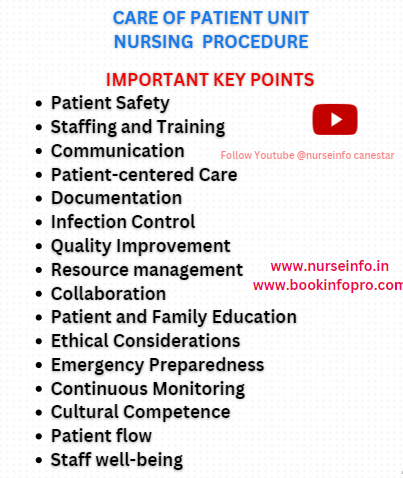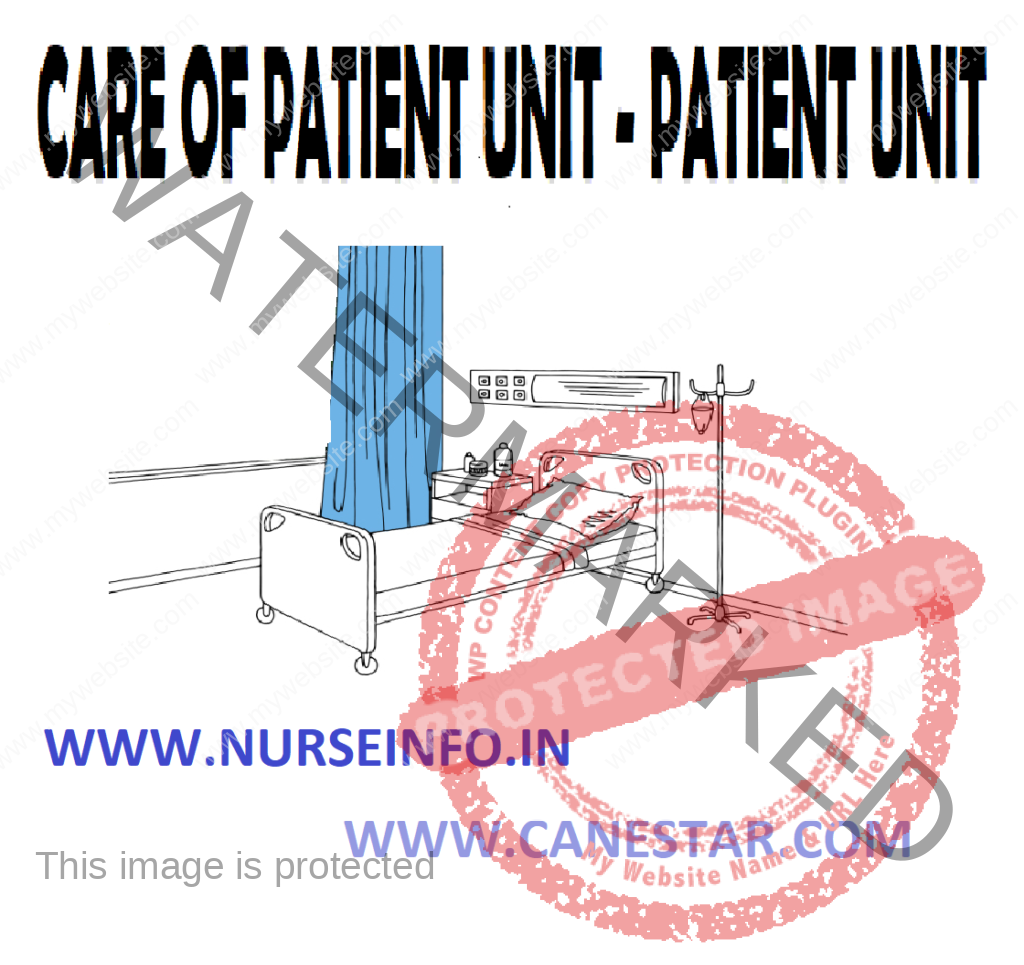Updated 2024
CARE OF PATIENT UNIT
The duty of the nurse is to ensure that the patients unit is kept clean and tidy at all times. She should learn all the cleaning skills in order to teach others and should willingly clean where necessary. The patient and his relatives are also taught to keep the unit clean and tidy.
COMMON NURSING ARTICLE AND PROCEDURE CLICK HERE
DEFINITION
- Care of patient unit is defined as keeping the patients unit clean, neat and tidy. It also helps to provide maximum comfort to the patient
- Patients unit is the area furnished and equipped according to the need to give adequate care to the patient
- Sufficient air movement to evaporate sweats and favors vascular changes within the skin
- Atmospheric pressure within man’s tolerance
- Provision for disposed of refuse/excreta
- Removal of dust. Injurious chemicals and pathogenic bacteria from the atmospheric air
- Reasonable cleanliness of all surface and furnishing that the individual is likely to handle
- A dwelling place free from insects, animal pests, fire hazards, mechanical injuries, electric shocks, radiation and poisons
- Freedom from disagreeable odors and noises, harmony of town and design in the immediate surroundings, provision of privacy etc

INFLUENCE OF EXTERNAL ENVIRONMENT
Atmospheric temperature: in an ideal temperature, the person does not feel chilly, but it should be sufficiently warm enough to cause perspiration. A room temperature ranging from 68 to 72 degree F (20-22 degree Celcius) is considered comfortable
Humidity: humidity is the amount of moisture in the air. It affects the evaporation of moisture from the skin. A humidity of 40-60% considered comfortable
Air Movement
Ventilation means movement in the air. The chief purpose of ventilation is to supply fresh air and to maintain a proper humidity. Air in motion increases the radiation of heat from the skin and improves circulation and respiration. The velocity of the air movement should be 15-45 feet/minute or 1-3 miles/hour
Air may keep in motion by opening doors and windows, and by the use of fans and air conditioners. The air movement should not be much to cause draughts.
Lighting
The amount of light is an important factor in comfort. It is provided by natural or artificial light. Avoid direct light on the face and eyes. Prevent glare. Artificial light should not be too strong for reading. Remember, it is difficult for a patient to rest when there is excessive light.
He will not be able to read and write when there is dim light. The amount of light depends upon the use of light, the kind of work being done, conditions of the patient, age of the patient and the time of the day. The patient if conscious should have within his reach a light, which he can control
COMMON NURSING ARTICLE AND PROCEDURE CLICK HERE
Noise
Noise produces irritability, restlessness, fatigue, and exhaustion. In an acutely ill patient noise interfere with sleep. On the contrary, a melodious sound induces pleasure. The degree of noise may be reduced by various measures. Noise caused by friction may be reduced by various measures. Noise caused by friction may be reduced by lubrication. Use of rubber tyres and castors for trolleys and wheel chairs reduce the sound when moving furniture. Make echo proof rooms. Avoid dropping object. Loud talking, laughing and heavy walking with shoes should be avoided. Whispering is also not good, as it tends to cause apprehension and uncertainty in the patient
Purity of the Air
Dust cause significant hazards to patients. Dust in hospital may be laden with microorganisms, which cause infection in addition to irritation of the respiratory tract of precipitating allergic reaction
To control the dust, it is important to avoid those activities that stirrup dust such as dusting and dry duster and sweeping damp dusting and cleaning, folding bed linen and gently shaking them rather than flapping them, restricting the cigarette smoking and above all providing proper ventilation and ample spacing of bed maintains the purity of air.
Elimination of Unpleasant Odors
Good ventilation, cleanliness, proper disposal of excreta and rubbish are necessary to eliminate unpleasant odors
Water Supply and Sewage Disposal
There should be provision for safe water supply and disposal of excreta
Esthetic Factor
The environment becomes attractive it appeals to the series whether we are conscious or not, the design or arrangement of the room contributes to its harmony. Through skillful use of color, the room can be made attractive. Color preferences vary with age, sex and race. Flower vase, picture and curtains add to the pleasant outlook of the room
Esthetic considerations should include freedom from unpleasant sights, bedpans, urinals, soiled dressings and used linen, etc, should be removed from the sick room immediately.
Optimum Environment for the Patient
Influence of external environment are atmospheric temperature, humidity, air movement, lighting, noise, purity of air, elimination of unpleasant odors, water supply and sewage disposal and esthetic factors.
Factors of safety include freedom from mechanical injury, thermal injury, chemical injury, radiation, bacteriologic ingests, allergens, free from vermin, insects and animal pests.
Furnishing for the patients unit are cot, spread over bed, table, bedside locker, bedside table, chair and stool, bedside commode, bed pans, and urinals, sputum cup, kidney trays, water flasks, and drinking glasses, plate, spoon, fork, knives and toilet articles.
Carliolization
Carliolization is a process of disinfecting the whole external environment of the patient and rendering it free from pathogenic organisms.
Vermin and Insects
- Clean the patients unit regularly. Eliminate all the breeding places. Keep garbage well-covered and dispose of all refuse properly
- Store food properly. Use fly screens on windows and doors.
FURNISHING PATIENT UNIT
Cot or bedstead: the hospital beds are made up of metal, simple in design, light and easily moveable, easy to clean, and strong durable with hard rubber castors. Some bed will have side rails to prevent the patient from falling.
Over bed table or cardiac table: generally, this is used for patients suffering from cardiac diseases to lean and rest forward when he has breathing difficulty. It can also use for eating, reading, and writing and for placing articles for self care.
Bedside locker: it is used to store the patient personal articles
Bedside table: it can be used for taking the meals and other purposes.
Chair and stool: the chair can be used for the patients when he is out of bed, i.e. while changing the bed linens or bathing the patients. The workers and visitors should sit on the chair and not on the patient’s bed.
Bedside commode: it is a chair or wheelchair that has opening in the center of a seat under which a bedpan can be inserted. It is used for defecation and urination.
Bedpan and urinals: for a bedridden patient, these are used for defecation and urination.
Sputum cup: it is used to collect the sputum and spitting
Kidney tray: it is used to collect vomits body fluids and soiled dressings
Water flask and drinking glasses: the water flask is filled with drinking water and is given to the patient within his reach.
Plate, spoon, fork, knifes, etc: these are used to serve the meals for the patient and is kept in-patients unit
Call signal: a bell is kept near the patient to call the nurse in his need
Toilet articles: soap with soap dish, toothbrush and toothpaste, mouthwash, comb, etc. are kept in patients unit. Bucket, mug, basin, etc. are kept in bathroom.
Waste basket: it is used to collect the rubbish
Bedding and bed linens: the mattresses and pillows should be firm, thick and smooth and all should have a washable cover. It gives support to the patients. Bed sheets are made up of strong cotton material, which are used to protect the mattress from soiling and to cover the patients; draw Mackintosh sheet, extents from the patient shoulder to below knee, made up of rubber or plastic material, which is used to protect the mattress and bottom sheet from soiling. Sometimes, Kelley’s pads are used in place of a Mackintosh.
PURPOSE OF THE UNIT CARE
- To provide comfort to patient
- To prevent cross infection
- To keep the unit clean and neat
- To keep the unit away from microorganisms
- To keep the articles ready for use
- To prolong the life of the articles
PRINCIPLES OF GOOD HOUSEKEEPING
- Wear gloves before cleaning the unit
- Use a damp dusting
- Dust with firm and even strokes
- Use disinfectant for cleaning
- Use a brush to clean grooved surface
- Remove albuminous materials such as sputum with cold water
- Expose cleaned area to sunlight as it helps destroy bacteria
Keep the cleaned articles in an orderly fashion
TYPES OF WARDS IN PATIENT UNIT & PRINCIPLES OF CLEANING
DISINFECTION IN THE PATIENT UNIT
TERMINAL CLEANING OF PATIENT CARE UNIT

NURSING PROCEDURES LIST CLICK HERE
NURSING IMPORTANT QUESTIONS – CLICK HERE
CARE OF PATIENT UNIT – KEY IMPORTANT POINTS
here are some important key points to consider:
- Patient Safety:
- Implement measures to ensure patient safety, including fall prevention, infection control, and the reduction of medical errors.
- Staffing and Training:
- Ensure an adequate number of qualified staff members with appropriate training and skills to meet the needs of patients.
- Communication:
- Foster effective communication among healthcare professionals, patients, and their families to enhance care coordination.
- Patient-Centered Care:
- Promote patient-centered care by respecting individual preferences, involving patients in decision-making, and addressing their unique needs.
- Documentation:
- Maintain accurate and timely documentation of patient information, care plans, and interventions, following established protocols and privacy regulations.
- Infection Control:
- Implement and monitor infection control measures to prevent the spread of infections within the patient care unit.
- Quality Improvement:
- Participate in ongoing quality improvement initiatives to enhance patient outcomes and the overall efficiency of the unit.
- Resource Management:
- Efficiently manage resources, including medical supplies, equipment, and staffing, to optimize patient care and minimize waste.
- Collaboration:
- Encourage collaboration among healthcare team members, fostering a multidisciplinary approach to patient care.
- Patient and Family Education:
- Provide education to patients and their families regarding their conditions, treatment plans, and self-care strategies.
- Ethical Considerations:
- Uphold ethical standards in patient care, respecting autonomy, confidentiality, and the rights of patients.
- Emergency Preparedness:
- Develop and regularly update emergency preparedness plans to handle unforeseen situations or disasters within the unit.
- Continuous Monitoring:
- Implement continuous monitoring of vital signs, patient progress, and response to interventions to ensure timely adjustments to care plans.
- Cultural Competence:
- Foster a culturally competent environment, recognizing and respecting the diverse backgrounds and beliefs of patients and staff.
- Patient Flow:
- Optimize patient flow within the unit to minimize wait times, enhance efficiency, and improve overall patient satisfaction.
- Staff Well-being:
- Prioritize the well-being of healthcare professionals by addressing workload, providing support, and promoting a positive work environment.
- Regulatory Compliance:
- Ensure compliance with all relevant healthcare regulations, standards, and accreditation requirements.

